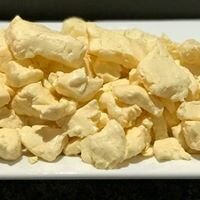What Are Cheese Curds and How to Enjoy Them According to Wisconsin Cheesemakers
They are a staple in Wisconsinites' refrigerators and pretty addictive when they are breaded and deep-fried. Oh, and their freshness is measured in the audible squeaking sound they make when you pop them in your mouth. Of course, we are talking about cheese curds, that quirky dairy product so beloved in the Midwest. But what’s the history behind this curious cheese? And can they be anything more than a glorified replacement for the mozzarella stick?
Making Cheese Curds
Cheese curds are made by filling vats with milk sourced from local farms and adding cultures and rennet. When the mixture becomes yogurt-like consistency it’s “cut” with wire knives, which allows the curds to fall to the bottom, after which they are cut into slabs that are stacked atop one another to allow the weight to make them thinner and denser. The slabs are sent through the miller (basically a cheese cutter) to turn them in their familiar shape; salt is added and the vat is stirred until ready to package. The remaining pieces of cheese can be pressed into a block, and the liquid remaining from the process contains cream that can be turned to butter, and whey used for land fertilizer.
Both tradition and the milk used in the region account for the great cheese, including the curds, says Kayla Scray, general manager of Scray Cheese in De Pere, Wisconsin. “The land and the climate play a big role in the quality of milk the cows will produce,” and the recipes and techniques have been passed down generations.”
Wisconsin’s Love of Cheese Curds
Back in the 1950s and 1960s, there were around 2,500 cheese factories in Wisconsin, according to Michael C. Brennenstuhl, master cheesemaker for Door Artisan Cheese in Egg Harbor, Wisconsin—practically one on every corner of the rural farmland. Factories typically had their own shops and encouraged customers to sample curds right out of the vat. “What a concept: point-of-sale advertising at its best,” he recalls. While the industry has evolved to a smaller number of larger factories spread out over the state, the local demand for curds hasn’t waned, and they are also sought-after souvenirs for visitors.
Types of Cheese Curds
Though a variety of types of cheese can be used for curds, they are usually made with cheddar or colby. Annatto, a derivative of the seeds of the achiote tree native to Mexico, is often used during the process to impart a yellow or orange color. Brennenstuhl points out that the color is merely for aesthetics, though he says it’s not uncommon for customers to specifically ask for white curds because they believe they taste better. What can affect the flavor are the ingredients that creative cheesemakers have been adding in the last decade or so, he says, like jalapeno and chipotle pepper, garlic and rosemary, peppercorn, and bacon and ranch. “Some curds are even sold with flavor packets so you can control the amount of spice you want to add.”
How to Enjoy Cheese Curds
"Poutine Pizza" by Canucklibrarian is licensed under CC BY-NC-SA 2.0
Renard’s Cheese, with locations in Sturgeon Bay and Algoma, Wisconsin, began producing cheese in 1961; today the company is in its third generation of cheesemaking, helmed by master cheesemaker Chris Renard and his wife Ann. Adjacent to their Sturgeon Bay location is Melt, a deli and restaurant where curds make an appearance in a Panzanella salad with seasonal greens, marinated red onions, tomatoes, Kalamata olives, and homemade sourdough croutons, atop a thin-crust pizza along with bacon, on a grilled cheese sandwich on sourdough with scallions and Dijon mustard, and of course, breaded and fried with sriracha aioli, garlic aioli or ranch sauces for dipping. They are also marinated for a full day in a mixture of olive oil, onion, garlic, and oregano and skewered with cherry tomatoes for an appetizer riff on Caprese salad. Scray uses them to dot the top of frozen pizza or garnish her chili and also mixes them with brown gravy as a topping French fries in the classic Canadian dish of poutine. But she believes plain curds eaten by themselves are really the bee’s knees.
"Poutine!" by vwcampin is licensed under CC BY 2.0
Either way, they are best eaten fresh and warm, Brennenstuhl says, which is also the time you will feel and hear that signature squeakiness. “The proteins in the cheese [are] tightly bound and your teeth running against those proteins creates the famous squeaking sound,” explains Franca Bueno, director of sales and public relations for Renard’s Cheese. Though they can be safely kept on the counter for up to twenty-four hours, once curds have been exposed to the cold temperature of the refrigerator, their texture changes, and while they are still tasty, their call is silenced. This is why squeaky curds are mainly a phenomenon in the Midwest, Scray notes: most of the time they just can’t be shipped quickly enough to other areas around the country to keep the squeak. (Scray and Renard’s both offer express shipping though, which should get the curds to most areas of the country with the squeak intact.) But today you can find locally-made curds in farmers’ markets and artisanal cheese shops all over the U.S.
And if your refrigerated curds become a little shy, Brennenstuhl suggests popping them in the microwave for about ten seconds (or setting them on the counter for an hour) to restore the squeak. “You know what they say, ‘never let a good curd go to waste.’”






